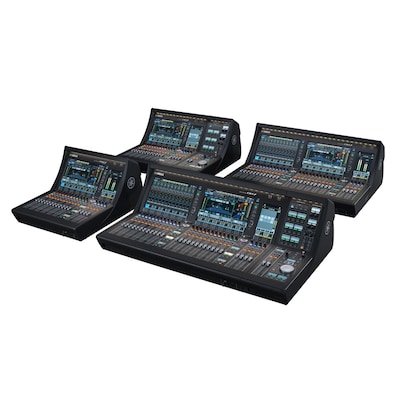World Class Solution - University of Birmingham is Ready for Anything with Yamaha DM7

University of Birmingham’s Department of Music is one of the most distinguished in the UK, with an illustrious history stretching back to 1905 and world-class research, teaching and study facilities. A Yamaha DM7 digital mixing console is the latest innovation to keep the University at the forefront of the study, practice and performance of music and as a world class venue for its busy conference and events department.
THE CHALLENGE
Opened 12 years ago, the Bramall Music Building finally completed the 1900 vision of the university's first Chancellor, Joseph Chamberlain. From the outside, it is a building which visitors would think has been there all the time. Funded by the Bramall Foundation, the £16 million facility includes state-of-the-art teaching, research, performance and rehearsal facilities, with a 450-seat auditorium at its heart.
Designed to be the most flexible performance space at a UK university, the auditorium is suitable for all types of music, from solo voice to a full symphony orchestra, as well as being the home for contemporary audio pioneers Birmingham Electroacoustic Sound Theatre (BEAST). When not being used for music, it is also a high-profile location for prestigious lectures, presentations, conferences and more.

“As well as a teaching and performance facility, it is also used for internal and external commercial activity,” says Richard Mitton, the university’s Live Events Technical Manager. “The University is big enough for us to easily facilitate large events – we have our own hotel on site and also the Great Hall, which can hold nearly a thousand people.”
With the University on an ambitious programme of expansion, a recent major upgrade to the Bramall Building’s infrastructure has been designed both to improve its teaching facilities and to sell the venue as a world class resource.
“The previous audio mixer was at the end of its life and massively limiting in terms of what we needed from channel counts and so on,” says Richard. “We started by sketching out what we wanted the upgraded system to do. The flexibility and power to easily handle a wide variety of events was vital, as well as the reliability to be in constant use and familiarity of the architecture and control for visiting engineers.”
THE SOLUTION
The chosen solution was a Yamaha DM7 digital mixing console, with a Dante network installed throughout the building. The DM7 system, supplied by Redditch-based 22live, includes the DM7 Control expansion controller, which allows features like user defined controls, scene memory and monitor control to be accessed even more quickly and conveniently.
“The capacity of the DM7 made it perfect for us,” says Richard. A lot of what we do is very mix bus heavy, with modern corporate events often requiring multiple streams, recordings and video feeds, as well as various monitor mixes and backstage/green room outputs. Features like 64 channels of Dan Dugan auto mixing are incredibly useful - we frequently have conferences that require extremely high numbers of radio mics, as well as multiple lecterns and large panel discussions. The split mode is really useful as well.”

One of the key purposes of the upgrade has been to build a core infrastructure which technical staff are not having to reconfigure all the time. Here the DM7’s Theatre Mode software is very useful for the university’s many regular presenters. Settings for each one can be stored in the software’s actor library, then Richard’s team can simply recall the event type and the presenters to achieve optimum settings in seconds.
The familiarity of the DM7’s user interface and architecture mean that visiting engineers also don’t waste any time in getting to work.
“The really difficult trick Yamaha has pulled off is to maintain the core workflow across the years. One of the first Yamaha mixers I used was an 02R. But you can walk up to the latest model and within about 10 minutes you're up to speed,” says Richard. “There is that consistency, everybody knows them. The build quality and reliability as well - it just feels like a step up from all the alternatives.”
Another major benefit of the DM7 is that it allows events to be hosted which weren’t possible before, as Richard explains.

“We had a recent concert that formed part of our Crosscurrents new music festival, which was being recorded for BBC Radio Three. Both direct and ambient microphone feeds from a string quartet on stage were routed to the console, then straight back out for real time processing as part of the performance. From there the feeds were routed back on separate channels to the DM7, for mixing to the main house PA, several effects loudspeakers and on stage monitoring.
A full channel split was then sent to the BBC for broadcast. The DM7 enabled us to quickly and easily route what was effectively three different versions of every input in, out, back in and out again.”
He continues, “The BBC likes the acoustics of the space and, where in the past an outside broadcast truck has been needed, engineers now just bring a small rack of interfaces and hook up to our infrastructure via Dante. It’s a huge saving in cost and time. There is also a permanent four-way PTZ camera system in the hall, so we can sell prospective clients the ability to broadcast, stream and do multi-track recordings of a live event, and do a full multi-camera shoot as well. Everything is all in one place.
“For all of these reasons, choosing the DM7 was a no-brainer. It ticks all the boxes with us. Without it we simply couldn't support a lot of the concerts or conferences and events we host, which going forward there will be more and more of.
“There's nothing that’s likely to come to this venue that the DM7 can't do. It makes us ready for anything.”
Location
United Kingdom

